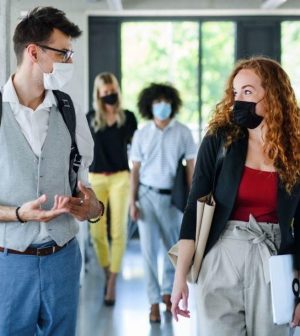- Navigating Your Midlife Crisis: Embracing New Possibilities
- City Raccoons Showing Signs of Domestication
- Mapping the Exposome: Science Broadens Focus to Environmental Disease Triggers
- One Week Less on Social Media Linked to Better Mental Health
- Your Brain Changes in Stages as You Age, Study Finds
- Some Suicide Victims Show No Typical Warning Signs, Study Finds
- ByHeart Formula Faces Lawsuits After Babies Sickened With Botulism
- Switch to Vegan Diet Could Cut Your Greenhouse Gas Emissions in Half
- Regular Bedtime Does Wonders for Blood Pressure
- Dining Alone Could Mean Worse Nutrition for Seniors
Mask Up or Not? One Factor Dictates a Social Norm

(HealthDay News) – Country by country, the percentage of people willing to mask up in a during the pandemic has varied greatly. Now, researchers have identified one key mindset that helps explain why.
A culture’s level of “collectivism” — prioritizing the group’s needs over an individual’s — influences whether someone is willing to wear a mask, researchers say.
“Collectivism versus individualism is one of the most established cultural dimensions in psychology,” noted study co-author Jackson Lu.
“Our data both within the United States and across the world shows that collectivism is a strong and important predictor of whether people in a region wear masks or not,” added Lu, an assistant professor at the Massachusetts Institute of Technology Sloan School of Management.
The study evaluated the impact of cultural differences on this element of pandemic response by using a series of datasets about mask usage and public attitudes, as well as information on collectivism. The researchers analyzed four datasets, two in the United States and two in other countries.
The U.S. datasets included more than 265,000 Americans in all 50 states.
The researchers examined how strongly mask wearing correlated with the measures of collectivism. A U.S. state’s collectivism can be graded based on survey responses by representative samples of the population, according to one of the studies.
Researchers controlled for other factors that might influence mask wearing, including the severity of COVID-19 outbreaks in states, government policies, political affiliations, education levels, population density, per-capita income, age and gender.
The research team found that a U.S. state’s collectivism rating is a strong and consistent predictor of mask usage.
Hawaii, for example, has the highest collectivism rating in the United States, and the second-highest level of mask usage, slightly behind Rhode Island. By contrast, a handful of states from the Great Plains and Mountain West have both low collectivism scores and low levels of mask wearing. They include Wyoming, South Dakota, Montana and Kansas.
“The patterns across the two U.S. datasets are so strikingly similar, which made us feel confident of the link between collectivism and mask use,” Lu says.
Also in the United States, researchers found that political party affiliation was a strong predictor of mask wearing, with Democrats more likely to wear masks than Republicans.
For global data, researchers used an analysis of more than 367,000 people from 29 countries and territories.
They also used a dataset the MIT researchers developed in collaboration with Facebook, creating a weighted survey on mask use that generated responses from more than 277,000 participants in 67 countries and territories.
They found that collectivism scores globally predicted which countries tended to have high levels of mask wearing.
The authors suggested that the role of collectivism could be studied in other crises, such as wildfires or hurricanes. They also noted it would be important to study whether the pandemic itself has affected the sense of collectivism or individualism.
“Understanding cultural differences not only provides insight into the pandemic, but helps the world prepare for future crises,” Lu said.
The findings were published May 20 in Proceedings of the National Academy of Sciences.
More information
The U.S. Centers for Disease Control and Prevention has more about COVID-19 protection measures.
SOURCE: Massachusetts Institute of Technology, news release, May 20, 2021
Source: HealthDay
Copyright © 2025 HealthDay. All rights reserved.










